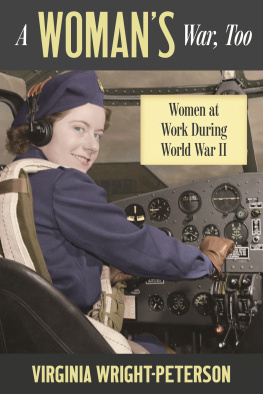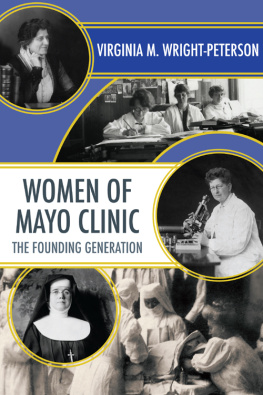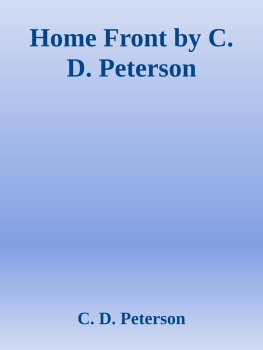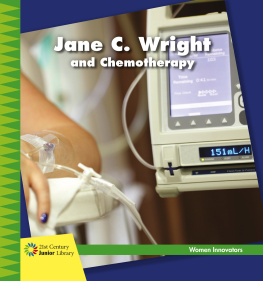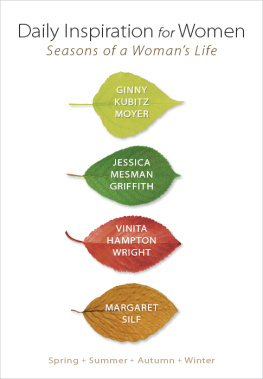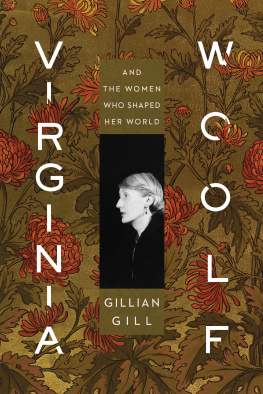Virginia Wright-Peterson - A Womans War, Too: Women at Work During World War II
Here you can read online Virginia Wright-Peterson - A Womans War, Too: Women at Work During World War II full text of the book (entire story) in english for free. Download pdf and epub, get meaning, cover and reviews about this ebook. year: 2020, publisher: Minnesota Historical Society Press, genre: Politics. Description of the work, (preface) as well as reviews are available. Best literature library LitArk.com created for fans of good reading and offers a wide selection of genres:
Romance novel
Science fiction
Adventure
Detective
Science
History
Home and family
Prose
Art
Politics
Computer
Non-fiction
Religion
Business
Children
Humor
Choose a favorite category and find really read worthwhile books. Enjoy immersion in the world of imagination, feel the emotions of the characters or learn something new for yourself, make an fascinating discovery.
- Book:A Womans War, Too: Women at Work During World War II
- Author:
- Publisher:Minnesota Historical Society Press
- Genre:
- Year:2020
- Rating:3 / 5
- Favourites:Add to favourites
- Your mark:
- 60
- 1
- 2
- 3
- 4
- 5
A Womans War, Too: Women at Work During World War II: summary, description and annotation
We offer to read an annotation, description, summary or preface (depends on what the author of the book "A Womans War, Too: Women at Work During World War II" wrote himself). If you haven't found the necessary information about the book — write in the comments, we will try to find it.
A Womans War, Too: Women at Work During World War II — read online for free the complete book (whole text) full work
Below is the text of the book, divided by pages. System saving the place of the last page read, allows you to conveniently read the book "A Womans War, Too: Women at Work During World War II" online for free, without having to search again every time where you left off. Put a bookmark, and you can go to the page where you finished reading at any time.
Font size:
Interval:
Bookmark:

A WOMANS WAR, TOO
A WOMANS War, Too
Women at Work During World War II
VIRGINIA M. WRIGHT-PETERSON


This activity is made possible by the voters of Minnesota through a grant from the Southeastern Minnesota Arts Council thanks to a legislative appropriation from the Arts & Cultural Heritage Fund.
Text copyright 2020 by Virginia M. Wright-Peterson. Copyrights for images are indicated with their captions. Other materials copyright 2020 by the Minnesota Historical Society. All rights reserved. No part of this book may be used or reproduced in any manner whatsoever without written permission except in the case of brief quotations embodied in critical articles and reviews. For information, write to the Minnesota Historical Society Press, 345 Kellogg Blvd. W., St. Paul, MN 55102-1906.
mnhspress.org
The Minnesota Historical Society Press is a member of the Association of University Presses.
Manufactured in the United States of America
10 9 8 7 6 5 4 3 2 1
 The paper used in this publication meets the minimum requirements of the American National Standard for Information SciencesPermanence for Printed Library Materials, ANSI Z39.48-1984.
The paper used in this publication meets the minimum requirements of the American National Standard for Information SciencesPermanence for Printed Library Materials, ANSI Z39.48-1984.
International Standard Book Number
ISBN: 978-1-68134-151-4 (paper)
ISBN: 978-1-68134-152-1 (e-book)
Library of Congress Cataloging-in-Publication Data
Names: Wright-Peterson, Virginia M., author.
Title: A womans war, too : women at work during World War II / Virginia M. Wright-Peterson.
Other titles: Women at work during World War II
Description: Saint Paul, MN : Minnesota Historical Society Press, [2020] | Includes bibliographical references and index. | Summary: During World War II, women in Minnesotalike women across the countrymade bold, unconventional, and important contributions to the war effort. They enlisted in all branches of the military and worked for the military as civilians. They labored in factories, mines, and shipyards. They were also tireless peace activists, and they worked to relocate interned Japanese American citizens and European refugees. They served as cryptologists, journalists, pilots, riveters, factory workers, nurses, entertainers, and spies. This rich chronological account relates dramatic stories of women discovering their own potential in a time of national need, surprising themselves and othersand setting the roots of second-wave feminism.Provided by publisher.
Identifiers: LCCN 2019055252 | ISBN 9781681341514 (paperback) | ISBN 9781681341521 (ebook)
Subjects: LCSH: World War, 19391945WomenMinnesota. | World War, 19391945War workMinnesota. | WomenEmploymentMinnesotaHistory20th century. | World War, 19391945Minnesota. | United StatesArmed ForcesBiography. | WomenMinnesotaBiography.
Classification: LCC D810.W7 W75 2020 | DDC 940.3/77609252dc23
LC record available at https://lccn.loc.gov/2019055252
This and other Minnesota Historical Society Press books are available from popular e-book vendors.
Dedicated to my husband, Ralph (19221995),
who served with the US Army Twenty-Seventh Infantry Division (19431946),
including in Okinawa, Japan,
and as a
civil education officer in Niigata, Japan (19461949)
and to
all of the women, men, and children worldwide
who made contributions and sacrifices during World War II
CONTENTS
A WOMANS WAR, TOO
PREFACE
This book could have been thousands of pages long, filled with the stories of contributions and sacrifices made by women from every walk of life in every city, town, farm, and forest of Minnesota during World War II. I first became aware of the stories of a few women when I was writing Women of Mayo Clinic: The Founding Generation. As that book came to a close with the events of 1943, I learned about Julia F. Herrick, a biophysicist at Mayo Clinic in Rochester, Minnesota, who was recruited by the US Army Signal Corps during the war to conduct radar research at Fort Monmouth in New Jersey. Next, I found the harrowing and brave narrative of Ruth Erickson, a navy corps nurse from Virginia, Minnesota, who valiantly saved lives during the attack on Pearl Harbor.
Once I started collecting stories, there seemed to be no end. One story led to a dozen more, much beyond Rosie the Riveter or the dates, descriptions of battles, and stories of generals I learned about in school, a history almost entirely devoid of women. How could half of the population be left out of the history of such a critical period?
The women of Minnesota, like women throughout the United States, strove for peace and freedom during the World War II years in vital and varied ways. They built ships in the Duluth-Superior Harbor, replaced men in the mines of the Iron Range, and worked in factories throughout the state. Minnesota women were present in every branch of the military. At home and abroad, women served as cryptologists, journalists, pilots, riveters, mechanics, nurses, entertainers, and spies.
Nearly all of the women included in this book were born in Minnesota or were living in the state during the war. I also included a French woman who worked for the US Army before becoming a war bride and moving to Minnesota and a German Jewish woman whose involvement in the resistance movement resulted in her incarceration in concentration camps; her connection to Minnesota came after the war when she became an internationally respected faculty member at the University of Minnesota. These women, as immigrants, brought with them important stories of courage, resilience, and dedication that should be recognized as an important part of Minnesotas heritage.
Perhaps most surprising is that in addition to important contributions at home, women from Minnesota directly witnessed and participated in many important milestones of the war overseas: the Battle of Britain, the fall and liberation of France, Operation Torch in North Africa, the reoccupation of the Aleutian Islands, D-Day, the Battle of the Bulge, the liberation of Dachau concentration camp, the reclamation of the Philippines and New Guinea, the Manhattan Project, and the dropping of the atomic bombs in Japan.
I found many more stories than I could include in this book. And yet, I am certain there are many stories of bravery and sacrifice that I did not find. Please consider these narratives to be a sample of what actually occurred. I was committed to including stories from women of all races, classes, and areas of the state, which was challenging. According to the US Census, Minnesota was 99.2 percent white in 1940. My research is also somewhat biased because white, educated, and economically privileged people are more likely to leave behind written records of their lives, and those records are more likely to be preserved in historical societies and libraries than those of women of color, women with less formal schooling, and women of less economic means. In addition, white, formally educated, middle-class women were more likely to be accepted into the military and employed by businesses during the war. Native American women are also an important part of the World War II story. I included one powerful story of an Ojibwe woman from White Earth and her community in Minneapolis; I suspect there are many more stories that could accompany hers.
Next pageFont size:
Interval:
Bookmark:
Similar books «A Womans War, Too: Women at Work During World War II»
Look at similar books to A Womans War, Too: Women at Work During World War II. We have selected literature similar in name and meaning in the hope of providing readers with more options to find new, interesting, not yet read works.
Discussion, reviews of the book A Womans War, Too: Women at Work During World War II and just readers' own opinions. Leave your comments, write what you think about the work, its meaning or the main characters. Specify what exactly you liked and what you didn't like, and why you think so.

